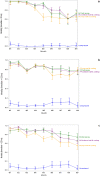Efficacy of partial spraying of SumiShield, Fludora Fusion and Actellic against wild populations of Anopheles gambiae s.l. in experimental huts in Tiassalé, Côte d'Ivoire
- PMID: 37443329
- PMCID: PMC10344869
- DOI: 10.1038/s41598-023-38583-y
Efficacy of partial spraying of SumiShield, Fludora Fusion and Actellic against wild populations of Anopheles gambiae s.l. in experimental huts in Tiassalé, Côte d'Ivoire
Abstract
From August 2020 to June 2021, we assessed the efficacy of SumiShield 50WG (clothianidin), Fludora Fusion 56.25WP-SB (mixture of clothianidin and deltamethrin) and Actellic 300CS (pirimiphos-methyl) in experimental huts when partially sprayed against wild, free-flying populations of Anopheles gambiae s.l. in Tiassalé, Côte d'Ivoire. A one-month baseline period of mosquito collections was conducted to determine mosquito density and resting behavior in unsprayed huts, after which two treatments of partial indoor residual spraying (IRS) were tested: spraying only the top half of walls + ceilings or only the bottom half of walls + ceilings. These were compared to fully sprayed applications using the three IRS insecticide formulations, during twenty nights per month of collection for nine consecutive months. Mortality was assessed at the time of collection, and after a 24 h holding period (Actellic) or up to 120 h (SumiShield and Fludora Fusion). Unsprayed huts were used as a negative control. The efficacy of each partially sprayed treatment of each insecticide was compared monthly to the fully sprayed huts over the study period with a non-inferiority margin set at 10%. The residual efficacy of each insecticide sprayed was also monitored. A total of 2197 Anopheles gambiae s.l. were collected during the baseline and 17,835 during the 9-month period after spraying. During baseline, 42.6% were collected on the bottom half versus 24.3% collected on the top half of the walls, and 33.1% on the ceilings. Over the nine-month post treatment period, 73.5% were collected on the bottom half of the wall, 11.6% collected on the top half and 14.8% on the ceilings. For Actellic, the mean mortality over the nine-month period was 88.5% [87.7, 89.3] for fully sprayed huts, 88.3% [85.1, 91.4] for bottom half + ceiling sprayed walls and 80.8% [74.5, 87.1] for the top half + ceiling sprayed huts. For Fludora Fusion an overall mean mortality of 85.6% [81.5, 89.7] was recorded for fully sprayed huts, 83.7% [82.9, 84.5] for bottom half + ceiling sprayed huts and 81.3% [79.6, 83.0] for the top half + ceiling sprayed huts. For SumiShield, the overall mean mortality was 86.7% [85.3, 88.1] for fully sprayed huts, 85.6% [85.4, 85.8] for the bottom half + ceiling sprayed huts and 76.9% [76.6, 77.3] for the top half + ceiling sprayed huts. For Fludora Fusion, both iterations of partial IRS were non-inferior to full spraying. However, for SumiShield and Actellic, this was true only for the huts with the bottom half + ceiling, reflecting the resting site preference of the local vectors. The results of this study suggest that partial spraying may be a way to reduce the cost of IRS without substantially compromising IRS efficacy.
© 2023. The Author(s).
Conflict of interest statement
The authors declare no competing interests.
Figures




References
-
- WHO. World malaria report. World Health OrganizationISBN 978-92-4-001579-1, 299 (2020).
-
- WHO. Indoor residual spraying: an operational manual for indoor residual spraying (IRS) for malaria transmission control and elimination – 2nd ed. World Health OrganizationISBN 978 92 4 150894 0, 134 (2015).
-
- Osae M. Resting Behaviour of Endophilic Anopheline Vectors in Three Ecological Zones of Southern Ghana and its Implications for the Use of Entomopathogenic Fungi. University of Ghana; 2014.
Publication types
MeSH terms
Substances
LinkOut - more resources
Full Text Sources
Medical

